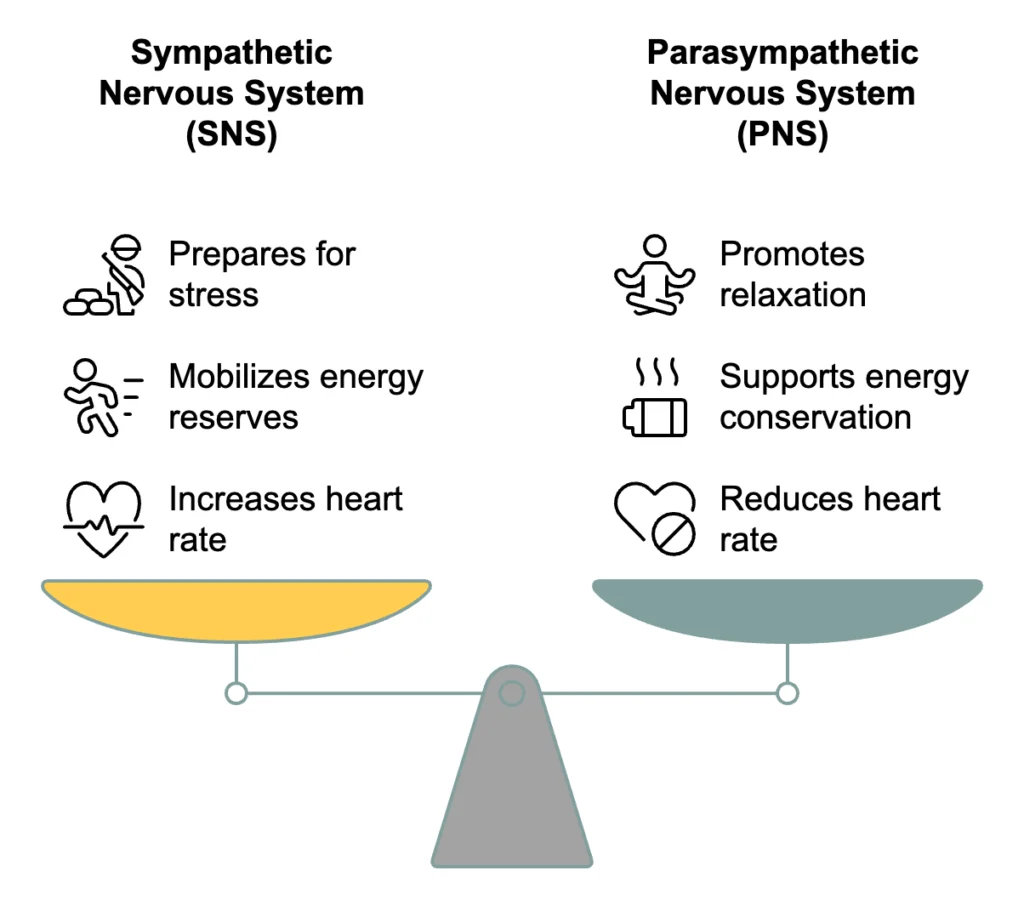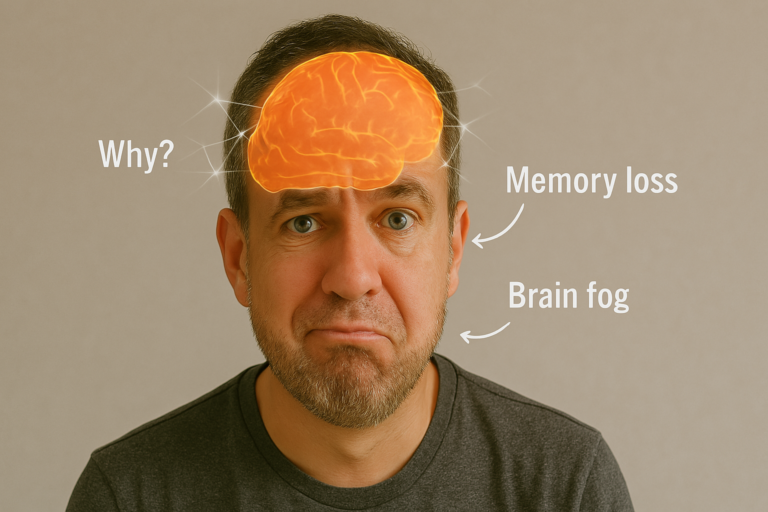
Table of Contents
- Emotional Dysregulation and Nervous System Imbalance
- Heightened Sensitivity to Stimuli: A Key Dysregulated Nervous System Symptom
- Chronic Fatigue and Nervous System Dysregulation
- Sleep Disturbances from Dysregulated Nervous System Symptoms
- Physical Manifestations of Dysregulated Nervous System
- Cognitive Impairments Related to Nervous System Dysregulation
- 7 Critical Dysregulated Nervous System Symptoms to Identify
- 7 Critical Dysregulated Nervous System Symptoms to Identify
Have you ever felt overwhelmed by stress, fatigue, or emotional turmoil without understanding why? These feelings may not just be a passing phase but rather symptoms of a deeper issue, and in this article we explain how to identify nervous system dysregulated symptoms.
As our bodies and minds constantly interact with the surrounding environment, maintaining harmony within our nervous system is crucial for overall well-being.
The nervous system, particularly the autonomic nervous system, plays an essential role in regulating our responses to stressors, both internal and external. The sympathetic and parasympathetic branches (outlined below), governs how we react to threats and manage rest and recovery.
What we know after working with hundreds of clients at the Integrated Health Foundation is that when there’s an imbalance between these responses, it can lead to significant disturbances that affect our daily lives.
In this article, we will explore critical symptoms indicative of nervous system dysregulation that you might be experiencing.
Understanding Your Dysregulated Nervous System

The nervous system is a complex communication network made up of nerves and specialized cells called neurons. These act like electrical wiring, transmitting signals between different parts of the body. Essentially, this system serves as the body’s command center, linking the brain and spinal cord to every organ, muscle, and sensory receptor.
Structurally, it is divided into two main components: the central nervous system (CNS) and the peripheral nervous system (PNS).
Think of it like a vast highway system. The CNS, the brain and spinal cord, acts as the major highways, directing and regulating essential functions such as thought, movement, emotion, breathing, heart rate, and body temperature. The PNS, on the other hand, consists of sensory neurons and nerves that function like smaller roads and side streets, carrying messages between the brain and the rest of the body.
The autonomic nervous system is a component of the PNS and acts like the specialized automated traffic control systems on these roads, like the traffic lights and walkway signs.
When traffic flows smoothly, everything works as it should, you think clearly, move easily, and feel balanced. However, if there’s congestion or a roadblock, signals slow down, leading to stress, fatigue, or other disruptions.
Maintaining a well-regulated nervous system is like keeping the roads clear and well-maintained, it ensures that your body and mind stay in harmony, supporting both mental and physical well-being.
Autonomic Nervous System Overview

The autonomic nervous system (ANS) is a distinct subdivision of the peripheral nervous system that specifically manages involuntary bodily functions, these are the processes that occur without our conscious awareness or effort. These include vital functions like heart rate, breathing, digestion, and blood pressure regulation. Within the ANS, there are two main branches, each playing a crucial role in maintaining bodily equilibrium: the sympathetic nervous system (SNS) and the parasympathetic nervous system (PNS).
- Sympathetic Nervous System (SNS): Known as the “fight-or-flight” system, the SNS prepares the body to respond to immediate stressors or perceived threats by accelerating the heart rate, redirecting blood to vital organs and muscles, and increasing alertness.
- Parasympathetic Nervous System (PNS): In contrast, the PNS supports “rest and digest” functions, promoting a state of relaxation by decreasing heart rate, aiding digestion, and conserving energy. A well-balanced ANS enables individuals to respond adaptively to changing internal and external environments, contributing significantly to mental and physical health.
However, dysregulation, often triggered by chronic stress or traumatic experiences, can result in various symptoms such as anxiety disorders, sleep disturbances, and chronic pain.
Sympathetic vs. Parasympathetic Responses
The balance between these two systems (the SNS and PNS above) is vital for nervous system regulation. The sympathetic nervous system’s activation during stressful situations intensifies responses necessary for survival. For example, if there’s a strong storm coming, you need to pack and you need to leave, you need your SNS activated! But when you are in constant flight or flight, your body is only producing stress chemicals which causes an imbalance within the nervous system.
While the parasympathetic nervous system counteracts this by calming the body and facilitating recovery once the threat has passed. However, if we remain in only the parasympathetic state, then there are adverse effects such as lack of emotions or inability to feel apathy.
Hence, a harmonious balance is necessary!

Disruption in this balance, where the SNS (the stress, fight and flight) dominates, can lead to heightened anxiety and stress.
This can be characterized by symptoms like a racing heart and elevated blood pressure. This was proven in a study of 126 participants published in the American Heart Association Journal .
Conversely, an overly active parasympathetic response may lead to decreased emotional responsiveness and feelings of apathy.
Let’s explore how this balance works below.
Key Points of Sympathetic vs. Parasympathetic Responses:

Maintaining a harmonious interaction between these systems is crucial for optimal cognitive, emotional, and physical health.
Let’s explore common symptoms our clients at the Integrated Health Foundation experience, and how to identify when the nervous systems are out of this balance.
7 Critical Dysregulated Nervous System Symptoms to Identify
Understanding the symptoms of a dysregulated nervous system is crucial for identifying and addressing potential issues that can significantly impact an individual’s quality of life.
A dysregulated nervous system can manifest in various forms, causing emotional, physical, and cognitive challenges.
Emotional Dysregulation and Nervous System Imbalance

Emotional dysregulation is a common consequence of a dysregulated nervous system, often making it difficult for individuals to manage and process their emotions effectively. This can lead to significant mood swings, frequent outbursts of anger, and episodes of excessive crying or emotional numbness.
Individuals dealing with this may also experience a reduced ability to feel joy or pleasure, impacting their overall quality of life. We also see a lot of anxiety, because heightened anxiety is prevalent, leaving individuals in a constant state of worry and hypervigilance, which can deplete emotional resources and increase irritability, further complicating daily interactions and coping with stress.
An example of emotional dysregulation linked to a dysregulated nervous system can be found in studies on children and adolescents.
Research has found that early-life stress, such as maltreatment or neglect, can lead to persistent changes in the amygdala and prefrontal cortex, impairing emotional regulation abilities.
For instance, children exposed to significant stressors often exhibit symptoms like mood swings, impulsivity, and difficulty processing emotions. This is further supported by findings that such stress can dysregulate the hypothalamic-pituitary-adrenal (HPA) axis, contributing to long-term emotional and behavioral challenges.
We see this often with clients that we work with, and it is a key reason we work to understand the root cause of where the dysregulation began. A lot of the time it is correlated directly to stressful times earlier in life.
Heightened Sensitivity to Stimuli: A Key Dysregulated Nervous System Symptom

Individuals with a dysregulated nervous system often experience heightened sensitivity to external stimuli, which can be overwhelming and debilitating. This sensitivity may manifest as strong reactions to loud noises, bright lights, or crowded environments and a deep awareness of the emotional states of others.
Have you ever found you are extremely senstivie to things like noise, light or often temperature? Perhaps, always feeling hot or always feeling cold.
Individuals experiencing these symptoms may be described as highly sensitive persons (HSP). This hypersensitivity can make routine interactions challenging, leading to feelings of being easily triggered or overwhelmed. This heightened type of sensitivity is a clear indication of potential nervous system imbalance.
A study on Sensory Processing Sensitivity (SPS) and Highly Sensitive Persons (HSPs) supports the idea that individuals with a dysregulated nervous system experience heightened sensitivity to stimuli. The fMRI study, “The Highly Sensitive Brain,” found that HSPs show greater awareness of subtle stimuli, stronger emotional reactivity, and a tendency to pause and assess new situations.
This sensitivity leads to deeper processing of environmental information, making individuals more emotionally responsive and prone to overstimulation. Research suggests that this heightened sensitivity is a fundamental trait rather than a disorder, affecting about 15-20% of the population.
These findings align with the idea that individuals with a dysregulated nervous system may feel easily overwhelmed by routine interactions and external stimuli (like sound, noise and temperature).
Chronic Fatigue and Nervous System Dysregulation

Chronic fatigue associated with a dysregulated nervous system is characterized by persistent, unrelenting tiredness that does not improve with sleep or rest. Individuals often feel groggy and exhausted throughout the day, hindering their ability to function effectively.
It can greatly impact concentration, diminishing the capacity to complete daily tasks, both personally and professionally. Recognizing chronic fatigue as a symptom emphasizes the need to address underlying nervous system dysregulation.
A study on autonomic nervous system (ANS) dysfunction in Chronic Fatigue Syndrome (CFS) found that individuals with CFS exhibit lower parasympathetic tone (the ‘rest and digest’) during deep sleep and higher sympathetic (the ‘fight or flight’) activity across all sleep stages, leading to unrefreshing sleep, a key symptom of chronic fatigue.
An article titled “Autonomic Nervous System Functioning Related to Nocturnal Sleep in Patients With Chronic Fatigue Syndrome,” observed higher nocturnal systolic blood pressure and lower heart rate, indicating disrupted autonomic regulation.
These findings suggest that sympathetic hyperactivity and reduced parasympathetic activity contribute to persistent fatigue, reinforcing the link between nervous system dysregulation and chronic fatigue and highlighting the importance of addressing ANS imbalances for symptom management.
If you are stuck in sympathetic hyperactivity – you are essentially in ‘fight or flight’ mode even when you’re sleeping!
Sleep Disturbances from Dysregulated Nervous System Symptoms

Sleep disturbances are a hallmark of nervous system dysregulation, typically marked by challenges in falling asleep or staying asleep. The body’s inability to transition out of a fight-or-flight mode as discussed above, impedes the relaxation necessary for restorative sleep, resulting in individuals waking up feeling unrefreshed.
Chronic stress contributes to sleep issues like insomnia and frequent awakenings, leaving individuals persistently fatigued upon waking.
Addressing these sleep disturbances by managing underlying stressors is key to improving overall sleep quality and nervous system health.
Research highlights a strong connection between sleep disturbances and nervous system dysregulation, showing that an overactive sympathetic nervous system (“fight-or-flight” response) can disrupt sleep. A study published in the Journal of Clinical Sleep Medicine (2018) found that heightened sympathetic activity and reduced parasympathetic tone during deep sleep impair the body’s ability to relax and achieve restorative rest.
Additionally, chronic stress is linked to poor sleep quality, insomnia, reduced deep and REM sleep, and frequent awakenings. Studies suggest that managing stress and nervous system regulation is key to improving sleep quality and overall well-being.
For many of the clients we work with, sleep is a consistent issue. Often finding it difficult to fall asleep, and waking up feeling wide awake in the night. A key pillar of the Integrated Health Foundation protocol includes lifestyle adaptations, to incorporate stress management techniques and restore the body’s circadian rhythm in order to improve sleep as sleep is such a fundamental necessity in the journey to recovery.
Physical Manifestations of Dysregulated Nervous System

Physical symptoms often accompany nervous system dysregulation, indicating its extensive impact on bodily functions. Frequent headaches suggest significant strain on the nervous system, while gastrointestinal issues such as constipation and irritable bowel syndrome point to autonomic nervous system imbalances.
Chronic pain, muscle tension, and fatigue highlight physical health challenges stemming from nervous system dysregulation. Symptoms like tingling and numbness in various body parts indicate potential peripheral nervous system issues, further affecting sensation and comfort. These physical manifestations often intertwine with sleep disturbances, underscoring the interconnectedness of nervous system health with overall physical well-being.
A 2022 study published in BMJ Neurology Open highlights the physical symptoms of nervous system dysregulation, particularly in patients with moderate-to-severe traumatic brain injury (msTBI). Findings revealed that gastrointestinal issues were the most common symptom, followed by orthostatic symptoms like dizziness and fatigue.
Other autonomic symptoms included abnormal sweating, nausea, bloating, constipation, diarrhea, dry eyes, thermodysregulation, and visual disturbances. These results support the idea that nervous system dysregulation can manifest in widespread physical symptoms, impacting multiple bodily functions and overall well-being.
Cognitive Impairments Related to Nervous System Dysregulation

Cognitive impairments are a significant aspect of nervous system dysregulation, leading to difficulties with concentration and focus. Individuals may experience memory problems, such as trouble recalling or retaining new information effectively.
Persistent brain fog, marked by confusion and difficulty concentrating, is exacerbated by prolonged stress or unresolved emotional trauma. Racing thoughts and an inability to focus on single tasks can lead to feelings of overwhelm and frustration. These symptoms impact decision-making and reduce mental clarity, affecting individuals’ personal and professional lives. Addressing these cognitive impairments is essential for improving overall nervous system health and functionality.
A cohort study on autonomic dysregulation and cognition found that imbalances in the autonomic nervous system (ANS) were strongly linked to cognitive impairments such as brain fog, memory problems, and difficulty concentrating.
The research showed that individuals with depression, a condition often tied to chronic stress and nervous system dysfunction, experienced worse cognitive performance than healthy controls.
These findings support the idea that nervous system dysregulation can impair attention, memory, and decision-making, affecting overall cognitive function.
Conclusion: Taking Action on Your Dysregulated Nervous System Symptoms

The journey toward understanding and addressing dysregulated nervous system symptoms begins with awareness.
If you’ve recognized several of the symptoms we’ve discussed such as emotional dysregulation, heightened sensitivity, chronic fatigue, sleep disturbances, physical manifestations, or cognitive impairments it is evident that you may be experiencing nervous system dysregulation that deserves attention and care.
Living with dysregulated nervous system symptoms doesn’t have to be your permanent reality. The nervous system possesses remarkable adaptability and, with the right approach, can be guided back toward balance and optimal functioning. Addressing these symptoms isn’t just about alleviating discomfort; it’s about reclaiming your quality of life and unlocking your full potential for wellbeing.
The first step toward healing begins with a comprehensive understanding of your unique symptom pattern. Our team at the Integrated Health Foundation has developed a specialized Symptoms Evaluation Assessment designed specifically to identify dysregulated nervous system symptoms and create a clearer picture of your current state.
This free assessment takes just a few minutes to complete but provides valuable insights into your specific dysregulated nervous system symptoms and potential pathways for recovery. By completing this assessment, you’ll gain:
- A personalized analysis of your dysregulated nervous system symptoms
- Insights into potential underlying causes of your symptoms
- Initial recommendations tailored to your unique situation
- Access to resources designed to support nervous system regulation
Your nervous system affects every aspect of your physical and mental wellbeing.
By taking proactive steps to address dysregulated nervous system symptoms today, you’re investing in a healthier, more balanced tomorrow.
Take our free Symptoms Evaluation Assessment now and begin your journey toward nervous system healing and renewed vitality.
Evaluate Your Symptoms: Do You Have Dysautonomia?
Take our quick and comprehensive symptom assessment to find out if your symptoms align with dysautonomia and receive personalized insights.
Share This Article
Read More Articles

Compression Socks for POTS
Most POTS patients waste money on the wrong compression garments, making symptoms worse instead of better. If you’ve been struggling with Postural Orthostatic Tachycardia Syndrome

Dysfunction of Nervous System
Are you experiencing unexplained symptoms that doctors can’t seem to pinpoint?
A dysfunction of nervous system might be at the root of your health

Nervous System Dysregulation Treatment: Evidence-Based Approaches for Recovery
Are you feeling like your body is betraying you, with symptoms that seem to defy explanation? You’re not alone. Millions struggle with nervous system dysregulation,


